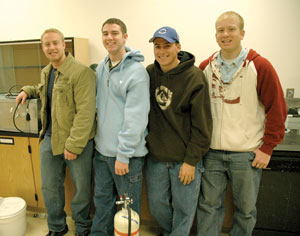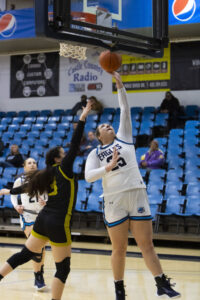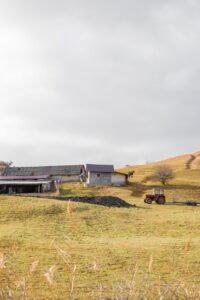Chemistry students research fire retardant
What happens when you mix bright, hard-working students with a stubborn maverick former military engineer turned chemistry instructor? In this case, as with their new formulation of fire extinguishing agent FEM-12SC, you get just the right mix.
Fire Extinguishing Material, 12th iteration, XX (FEM-12SC) is a patented revolutionary new fire extinguishing liquid invented by several former and current CEU science students including Derek Potter, Brett Riche, Matt Hyita and tutor Russell Scow. Spearheading and mentoring the project is George Uhlig Ph.D., CEU chemistry instructor.

This archived article was written by: Scott Frederick
What happens when you mix bright, hard-working students with a stubborn maverick former military engineer turned chemistry instructor? In this case, as with their new formulation of fire extinguishing agent FEM-12SC, you get just the right mix.
Fire Extinguishing Material, 12th iteration, XX (FEM-12SC) is a patented revolutionary new fire extinguishing liquid invented by several former and current CEU science students including Derek Potter, Brett Riche, Matt Hyita and tutor Russell Scow. Spearheading and mentoring the project is George Uhlig Ph.D., CEU chemistry instructor.
FEM-12SC has the potential to replace the dry chemicals found in almost every fire extinguisher available today. Advantages of FEM-12SC over water or dry chemical are dramatic. Most importantly FEM-12SC snuffs out the hottest, deadliest fires known to humankind without leaving the mess dry chemicals do. It contains mostly fertilizers which are safe enough to drink … but you wouldn’t want to.
For example magnesium, when ignited, presents critical problems for firefighters. The metal burns at 2,500 degrees Fahrenheit and is so hot that when sprayed with water the heat breaks the water down into its basic elements, hydrogen and oxygen. Instead of extinguishing the fire, water becomes more fuel, potentially causing fireballs, explosions and creating more hazards than it solves. To see video of what happens when a firefighter sprays water on a magnesium fire go to: www.Break.com/index/magnesium_explosion.html
According to the FAA (Federal Aviation Administration) website: faa.gov “Class D fires consist of the burning oxidation of certain combustible metals, such as magnesium, zirconium, titanium and lithium. Characteristics of magnesium fires consist of a hot-burning white flame with temperatures reaching beyond 2,500 °F. Methods of extinguishing metal fires include the use of sodium chloride dry powder on the source of the fire by crusting, smothering, or heat-transfer means, or to use large amounts of water at the source of the fire to cool the burning metal. However, when water-based products are used on metal fires, a violent, flaring explosion occurs.
“FEM-12 SC was chosen for its overall performance characteristics for extinguishing magnesium fires, as determined by the FAA ARFF Research Program during its combustible metal protocol fire tests. After the complete extinguishment of the magnesium fire, the magnesium remnants were substantially cooled enough to be picked up with a bare hand.”
The impact of the new fire extinguishing agent has started small but is growing, Uhlig explains, “I mean, people are throwing dry chemical extinguishers away. Dallas Ft. Worth [Airport] intends to replace all their dry chemical extinguishers from their aircraft crash and rescue [units] and they are going strictly to our solution because our solution [extinguishes] rubber tires, (four or five truck tires) in under 15 seconds when they’re really blazing, [extinguishes] magnesium fires. Most of the lightweight components in aircraft today are magnesium/aluminum. We’re going to composites in aviation … it is the only extinguishing agent to do [extinguish] composites at this stage. That includes glass and carbon.
“It will also knock down French-fry oil fires. Dry chemicals will knock the fire down, but it reignites. With our stuff, because we have water in it, it just sucks up the heat 1 … 2 … 3 and the fire is extinguished, and it stays out. And … you don’t have a mell-of-a-hess to clean up,” he jokes.
“The summary of this,” Uhlig continues, “is that the FAA certified for world-wide use a product that was developed in a two-year college from podunk Utah using young people from a rural area.”
Being awarded a patent for FEM-12SC is a coup for the students and instructors of the CEU science department … but that’s not all they have up their sleeve. They also have two patents pending for two slightly more economical formulations that have potential applications closer to home; extinguish coal fires.
And even that’s not all … there are at least two other ongoing projects in the CEU science department that also look promising for applications in coal mines locally and worldwide.
Hyita, a mine engineering major, is working on a liquid chemical formulation that renders inert dangerous hydrogen sulfide gas released during the coal mining process. The idea is to mix the chemical with water and pump the mixture to the sprayers already in place.
Hyita explains the method the team uses to create, test and refine the formulations, “We meet on Mondays and discuss the possibilities of certain solutions we can make up. Dr. Uhlig would direct me to try certain things … then we would come up with the calculations to measure certain quantities of whatever we are using, we review the data together, if he approves of what he sees, then I’ll go into the lab and test the chemical formulation.”
His experiments involve forcing hydrogen sulfide gas through a chamber while spraying his liquid chemical solution on it from above. Gas enters the chamber on one end, gets sprayed with the chemical mixture and then as the gas exits the chamber on the other end, the concentration of the gas is measured to determine if the chemical solution reduced the amount of gas in the chamber. (Russell Hardy mine engineer for Consol Energy donated a hydrogen sulfide detector for Hyita to use in his experiments)
Hyita is famous for clearing the upper floor of the CEU Reeves Building during class time fall ’07 semester when he produced so much hydrogen sulfide gas that some of it escaped his chamber and drifted through the building.
Hydrogen sulfide smells like rotten eggs, hence its nickname rotten egg gas. Hyita was busy with his experiment and unaware to what was going on until campus police showed up after the floor had been evacuated. From then on, his classmates refer to him as: “Pepe Le Pew.”
Hyita is optimistic about the future of his solution. After two years of research and testing he hopes the next three months are enough to complete the project. I hope we are close enough to finish this before I graduate spring in spring ’08. “There’s a good chance … a good chance,” he says before he adds “I don’t want to jinx myself.”
The other project is being led by Riche. He is working on a project to locate and extinguish coal seam fires. Riche plans to use sensitive infra-red detecting equipment to locate underground coal fires and then use the new fire extinguishing agent to snuff them out and prevent them from re-igniting.
Potter has been working on FEM-12SC directly. Potter’s job is to mix small quantities of the fire suppression material, test it, and then if the recipe works mix up batches to fill fire extinguishers for testing on real-life fires.
The formulation has evolved and has been refined by Uhlig, and the students that have come before, but Potter has the liberty to tweak the formulation to meet specific logistical requirements such as altering the formulation slightly so it doesn’t clog the nozzle of a fire extinguisher.
Potter explains one facet of his job: “there are different ways to make [chemicals] go into solution [be dissolved] you can heat them up, you can not put so much [of one chemical] in … there’s a lot of different things we can do with the chemistry. If for some reason the mixture does not go completely into solution [liquid form] I figure how to get it into solution.”
Potter’s job is to formulate a mixture that can be used in existing fire extinguisher canisters. This makes using the chemical solution more attractive and economical because the existing infrastructure can be used. He is also working on the new formulations designed to be more economical to produce.
“This is a huge blessing for me in my life to work with Dr. Uhlig because of the friendship that we’ve made. He is a good friend to have and I know if I’m in a hard spot, I can ask him for help and he will be more than happy to help.”
Scow’s job is the tutor. “Russell is our tutor, not only does he teach kids as a tutor, he also has the opportunity of participating not only in this particular experiment … but anything we do,” said Uhlig. Although Scow does not conduct experiments or research on the project directly, Uhlig and the other students consider his role important to the success of the project.
If you talk with Uhlig about the breakthrough that led to the formulation, the word serendipitous makes its way into the conversation as he relates the story of how his former student, Angie Rodriquez [now Angie Scouby], accidentally mixed the wrong chemicals.
“Angie Rodriquez is responsible for making the mistake that put us where we are today. She grabbed the wrong jar of chemicals, dumped them together and by Jove, it worked like a champ. When we put the right chemicals together [according to my formulation at the time], it didn’t work! So I got Angie and looked at her and asked what in the hell have you done? Show me the bottle you used and lo and behold she could remember the bottle … she got it and that was the key … it’s all serendipitous. She got the name of the chemicals screwed up as they were very similar in name and just used the wrong one and that’s the key. That’s the way a lot of things are done in science. Her mistake led us to some other thoughts on the agent,” Uhlig said.
This story is about more than inventing new goop or techniques to put out fires though … it’s about people, and more precisely it’s about students, it’s about teachers creating a fertile environment for young imaginations and it’s about how we as citizens provide the infrastructure and support for such innovations and relationships to flourish.
Without exception, these four students and their instructor constantly and consistently shifted any accolades directed at themselves individually to the team as a whole.
“This science department [at CEU] need not take a back seat to anyplace, I’ve taught at the Air Force Academy the Air Force Institute of Technology, MIT and places like that on research and graduate scholarships … these kids are every bit as good as students attending those colleges, and what it tells you is the [young] generation is a good generation,” Uhlig said. When a former Air Force colonel says that about the tattooed, pierced, iPod generation, that are his students, that’s high praise indeed.
He encourages and supports his students beyond being tough, demanding and pushing them to think on their own.
Uhlig explains, “What I do is offer them [the students] a $1,000 a year scholarship to work with me which pays their books every semester.”
He continues, “My partner and I have not taken any salary; we’ve taken all the money that we have and dumped it into supporting students. The project cost us probably $40,000 and about $12,000 has come out of my hip pocket.” Current students Hyita and Potter have been beneficiaries of Uhlig’s personal scholarships.
Uhlig explains “I’m high on the kids … I stay here and teach because I love the kids. These kids are every bit as good as any kid that goes to MIT, or Stanford or anywhere else. The problem that you get into is I don’t think the high schools really challenge the kids but once they’re challenged … get out of their way.
“What they get from me is they get a mentor; they learn how to keep a research notebook and it’s because of their ability to keep a research notebook; that we were able to develop not one solution but two [additional] different solutions.”
“Most of the kids that I choose are those who I feel will make a great contribution. It’s either that or they need to be mentored to the point they’ll hustle because they have the potential. I’ve taken a couple of young people that have been introverted and through our association, they’ve become less introverted.”
“They understand they can win … that that’s a possibility for them. That is probably the first time they have won anything and that’s a name on a patent. And this is the important thing that you build up young people. I think these people [students who have worked on the project] are the sharpest knifes in the drawer, otherwise I would not have chosen them. They literally have the greatest potential for success. I don’t want an A student not interested in having fun while they are in school … I want a well rounded student.”
If the commercialization of FEM-12SC is successful Uhlig, his partner and their company: Thermic Labs LLC will award each student that worked on the project substantial cash compensation for their efforts.
According to Scow, “The main reason Dr. Uhlig does all the fire extinguishing stuff is for scholarships [to provide students with] and he has said if it all goes well, he will help us with graduate school. I know he also wants to set up some [additional] scholarship programs.”
“If it [money] comes, it’ll come and I will be grateful and happy about it, but if not, I definitely had a good time and learned a lot of things and have been able to grow as a person.”
Each of the four students in this story would use the money generated by the sale of FEM-12SC to further their education. Hyita is planning on attending the University of Utah and pursuing a degree in mining engineering. Riche, Potter and Scow plan on attending dental school wherever they are accepted.
Riche: “I’ll probably go to SUU (Southern Utah University) for the pre-dental stuff, and then I hope to go to Creighton if I could, or even Las Vegas just wherever I can get in is good for me. If all worked out it would be good to go to Creighton.”
How about it Creighton? Got a few slots open for hard-working students from Utah?
These four guys, the students that preceded them, and their instructors … have accomplished the American dream. If everything goes the way they hope, these committed people will have overcome odds and worked on a project that could change your life.
Imagine a house fire being knocked down in minutes instead of hours. Imagine a jumbo jet fire being reduced substantially in seconds … not minutes. Can you imagine wood or other material being treated with the material?
All four were reluctant to take credit for the success of the project … they cited other people’s work more than their own. At the same time they were simply self assured and relaxed.
This is a clear example of a great instructor knowing how, having the wherewithal, and brilliantly getting out of the way when appropriate. This is a guy that put his money where his mouth is.
This is what we need. This is what America really is … what it was … what we all hope it will be again.
Editors note: I want to thank Matt, Brett, Derek and Russell for their time. These four guys are a class act. These guys are humble, smart and confident. These guys are what America needs more of. These are the kind of guys that are going to invent a car that runs on air or water, has zero emissions, and is inexpensive to operate. These guys are the real deal.




